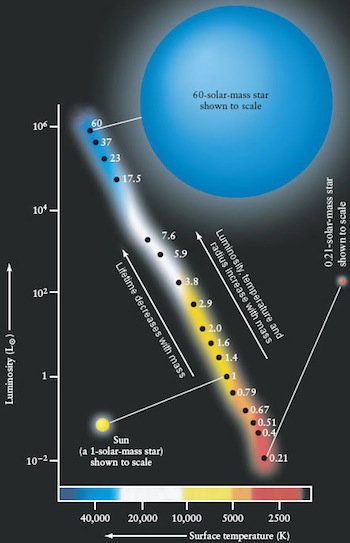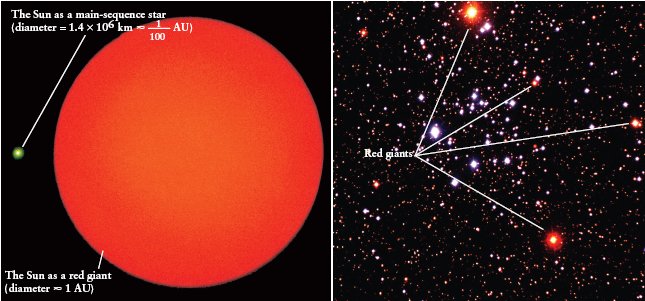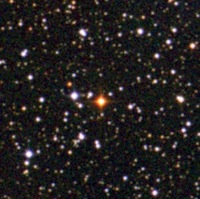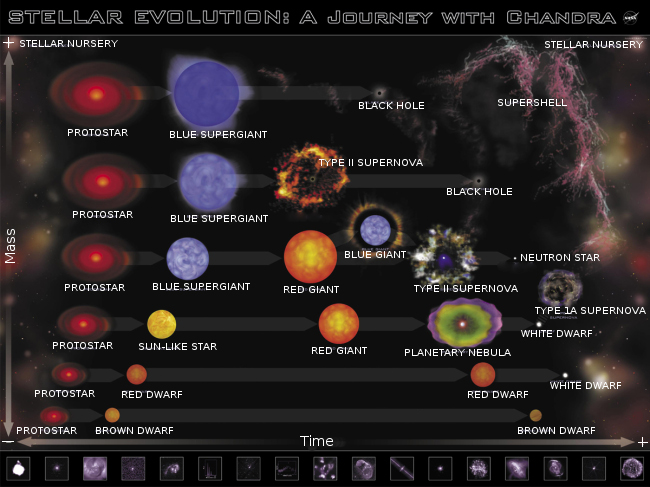Chapter 20. Life and Death Beyond the Main Sequence
20.1 Introduction

Author: Kristin Miller
Editor: Beth Hufnagel, Anne Arundel Community College

The goals of this module: After completing this exercise, you should be able to:
- Describe how the processes of stellar evolution are the same for three different ranges of initial masses.
- Describe how the changing source of internal energy dictates the course of stellar evolution.
- List the processes stars with initial masses from 0.4M\(\odot\)to 4.0M\(\odot\) go through as they age and die.
In this module you will explore:
- Why stars of differing masses end their lives as very different objects.
- How shell fusion affects a star radically differently than core fusion.
Why you are doing it: The death of a star is, in a very real sense, the story of our past and our future. Understanding how stars like our Sun end their lives, and how their fates differ from the fates of stars with different masses, is both interesting and relevant to the existence and fate of life on Earth.
20.2 Background

For an isolated star (that is, a star which is not a member of a multiple system), the star's mass is the most important factor that shapes its evolution. Mass dictates how quickly a cloud of gas and dust will collapse and form a new star. High mass fragments evolve much more quickly than their lower mass counterparts, reaching the main sequence after only hundreds of thousands of years compared to the billions of years required by very low mass stars.
Once on the main sequence, mass determines how long the star will remain in this stable phase, as well as which hydrogen fusion reactions will dominate in its core and how luminous the main-sequence star will be. More massive stars have short main-sequence lives and are more luminous than less massive stars. Stars more massive than about 2M\(\odot \) fuse hydrogen in their cores via the Carbon-Nitrogen-Oxygen (CNO) cycle, while in less massive stars like the Sun the proton-proton chain dominates. Stars with masses less than 0.4M\(\odot \) are completely mixed by boiling inside or convection, while more massive stars are convective in only a portion of their interiors.
Question 20.1
OIc5JU7j2AxCLNPgq+rd/S7YPs1EPow38DF7wKcguXdze/VWrDEF9yfK5WOJqwot6wNgltqRPxE2boQXFINpMkntAP7w9uWurq0Axs+Dn8MkfUQzRy5gLUmwG37TGrsKRhiI+f7cCj07gejQxL6hH4OklYf+J5SWXasBlD4ZQqWNHz1e095KSCQJepGgr2+FT+77njHxqRVCQcL7W1r4GE2wGmNhP+dn2ZKpaIljoovADAj0UoQV68vWSP/71DRMBz3GOAc/E/VrMD5i9Cpfo+RsIIuSi7YWBUo037qiz0cFL5L+CKMtHw7DHCSl5Eu7oRFUjo3NWUAoE0GrHnrrY+17VC2MPXvlKbIq2ieZc7FrKdOVRWtOncSbijQoAQaD+XQRtRPpi+F+VMfjpZ6vWDaj/DlCOJJ4qohLeZROVcMQQDZXrPuOdQ==Summary
It is truly astounding how much the mass of a star affects almost all areas of its evolution during its lifetime. Mass is also the determining factor that decides the ultimate fate of the star - both the manner of its death and the object it is destined to remain.
Stars naturally fall into three distinct groups:
- very low mass stars (masses from 0.08M\(\odot \) to 0.4M\(\odot \) )
- moderately low mass stars (masses from 0.4M\(\odot \) to 4.0M\(\odot \) )
- and high mass stars (masses greater than 4M\(\odot \) )
Within each group, stars evolve in the same manner with only minor differences. Stars with masses less than 0.4M\(\odot \) will end their main-sequence lives as boring inert balls of (mostly) helium gas and do it so slowly that there has not yet been enough time in the universe for any of them to evolve much. Therefore, we will study only the moderately low mass stars in the remainder of this activity. (High mass stars will be covered in another activity.)
20.3 Life As a Red Giant

The stage of evolution following the main-sequence phase is the red giant phase; the well-known red supergiant star Betelgeuse is shown. The journey to become a red giant is roughly the same for all stars greater than 0.4 M\(\odot \), but the details are mass dependent.
When a star exhausts its supply of hydrogen fuel in the core, its main-sequence life ends, but fusion doesn't stop. When hydrogen-to-helium fusion ends in the core, it can no longer support itself against the inward pull of gravity, so the core begins to contract. This contraction converts gravitational potential energy into kinetic energy; about half of the kinetic energy goes into increasing the temperature of the core, and the other half heats the surrounding layers of the star. But these surrounding layers are still rich in hydrogen, so a shell of hydrogen fusion forms around the helium core as the heat of the contraction raises the temperature above 10 million Kelvin. The more the core contracts, the more it heats the hydrogen shell, the faster the fusion reactions occur, and the more energy the shell produces. The net result is that the energy generation of the star actually increases when fusion ends in the core!
The extra energy output causes the outer layers of the star to expand, which in turn causes them to cool. Thus, our post-main-sequence star is bigger, cooler, and (due to the increase in energy generation and radius) brighter than it was on the main sequence. The star is now known as a red giant. For a solar mass star, it is roughly 100 times larger than it was on the main sequence - expanding almost half the distance to the Earth! This is shown in the following figure.

The red giant star continues to expand until the core's contraction raises its temperature to one hundred million Kelvin. This is hot enough for helium fusion to begin.
20.4 Life on Core Helium Fusion
For stars with masses greater than about 2M\(\odot \), helium fusion begins gradually and the star settles into a new equilibrium with a core of helium fusion and a surrounding shell of hydrogen fusion. For stars with mass less than about 2M\(\odot \), in order to reach the temperatures needed for helium fusion to begin, the core must contract until individual electrons are actually squeezed together; this is known as a degenerate state. When helium fusion begins in these degenerate conditions, energy is produced faster than the core can respond. For a few hours, helium fusion goes out of control in the core, and the temperature rises sharply. This is called the helium flash, although this event can't be seen since it stays deep within the star. Soon, however, the core catches up; it expands and cools, the rate of helium fusion stabilizes, and the star joins its higher mass counterparts in a stable phase of evolution known as the horizontal branch. Horizontal branch stars are sustained by helium fusion in the core and hydrogen fusion in a surrounding shell. This stage of evolution lasts roughly one hundred million years for a low mass star like the Sun. For higher mass stars, the time the star spends in this phase decreases.
The journey from main-sequence star to horizontal branch star is summarized in the following animation.

Question 20.2
/d4t2ZyAXEdc8Bv5EyGk0eOvredWMe9wzLNX2zCwpS2/UFEylHpQk502aKtDuv+RMvAsOxQor3cZsSUFDZx3Gc0aqHWGzsv/FzX2up++Eo547qtrMpvF8goAG/aT8Eo4VNNb8aCz1GQdQJRQ2WMmC8OoyW2iqmq7KN7sCvruz4+1fOoQJ7MTvEYRRpFOrJkWMMeDGJG3/7Om7F9C2PtEQevdlj+IkJj3szPsvmIzK1hN3EwifRaAd7iiS9oq5GDUV+BZIyr3+vy8Kx74IcH0JPURKmj9JupybdhjYR2k3hI3VxVAXMtezdW0xRK+7qtDHrHK1cZB2/6mV+BCghkFIGmpvjMRVHyYlJ45HELzctkNkTR4kaYp2lz72dpEJB4r5U0yk3WJS6LTVhTXLA/yuI+oiw4J8SS+kzRNKylDlHVoOGZXEtnSuhX6BSY5BATSgMfBYIuIjkHEB5W09qMrLiLRgdqIyovj9aPWmxkrAIfpTie9hFm0Nw==20.5 The Second Red-Giant Phase

When a star's supply of core helium is fused into carbon and oxygen, it leaves the horizontal branch just as it left the main sequence after depleting its supply of core hydrogen. At this point, the evolution of moderately low mass (0.4M\(\odot \)- 4M\(\odot \)) and high mass (greater than 4M\(\odot \)) stars, which has been roughly the same until now, begins to differ significantly. (The high-mass stars have their own, separate tutorial.)
When helium fusion stops in the core of a moderately low mass star, the core again begins to contract and heat up. The shell of hydrogen fusion that surrounded the core while on the horizontal branch continues to fuse, slowly moving farther out in the star as it consumes the hydrogen at each successive radius. This shell of fusion creates a shell of helium in its wake, which begins to fuse as it is heated by the contraction of the core. Thus, the star is now composed internally of a shrinking carbon/oxygen core surrounded by a shell of helium fusion, which is surrounded by a shell of hydrogen fusion. All of these layers are surrounded by the outer layers of the star, which respond to the increase in energy generation by expanding and cooling once more. The star again becomes a giant, this time even larger and more luminous than before. It is known as an Asymptotic Giant Branch Star (AGB star).
Question 20.3
6RmUIdQ5aSKy3nr7Lzutnhipz5ZKqy22gJABrKW32QikXpoVl40+v65X4TzNqmE6zRwSaim4Q7z0ygtleBJUaIbyKHTBQfHvVvSX4dTnxmkFAzqU6hjMZQ2H4IaemGh9Bejqm86plgZVhBAQSummary

As shown in the figure, AGB stars such as the Sun will become ten thousand times brighter than the Sun currently is, and engulf Mercury and perhaps Venus as well! Stars more massive than the Sun become even larger and more luminous AGB stars. As the star evolves in the AGB stage, it continues to expand and cool, eventually cooling enough that fusion ceases in the hydrogen fusing shell. At this point, the only fusion reactions taking place inside the star are in the shell of helium fusion, which alone supports the bright luminosity of the star.
The second red giant phase ends when hydrogen and helium shell fusion ends. For moderately low mass stars, however, fusion of the next core element - carbon - never takes place. These stars simply do not have enough mass to reach the temperatures and pressures needed for carbon fusion. Once a low-mass star becomes a giant for the second time, it has turned onto the one-way street that leads to its death as a white dwarf.
20.6 Summary: Main Sequence through Red Giant
We've covered a lot of material that is probably new to you, so let's pause and summarize the stellar evolution process, linking how the Herstzsprung-Russell diagram changes to the interior changes in the star.
The journey from main-sequence star to asymptotic red giant branch star is summarized in the following animation.

20.7 Ejecting the Outer Layers as a Planetary Nebula
Something else interesting is also happening at the surface of an AGB star. The internal pulses of energy actually cause the star to eject its outer layers! This can happen because, as the star expands, the outer layers become very spread out and can escape the star's gravity. Every time the helium and hydrogen fusion shells cycle, a layer of the AGB's star's upper atmosphere is puffed away as a glowing cloud of gas.
The ejected layers of the star are known as planetary nebulae, and spread out up to a light-year away from the star. Some astronomers like to study them because they are very beautiful objects, as shown in the pictures below.

Question 20.4
lkPw9NMIf3ItEJXDYwPwkRU/K46k3nP8VRbhTQtty/cJDCt0O15qj+AJ/T65Dl0EEUeV9RrjWYIXTAJ02evbSPr+Yjb491A8o30vXb+GA1lchxjyaiukbBBs5j1iYKzVBrhvUwyCL4CICIKHRMVbfWNunaydiCfWMdlYSxfYPzjo2NfuqQbun57twbrkcDcwG8knULhvB6mVsDiBt2N8qlT3o2mst4iBzqVdNEdYbU0SgWekAyQ9u3xzkdqoXT/ku8lNR+KLGpEKNYVXd4tCTBsHLgfGHiHkInVSFGtlT0Yi22/Ir85jc31y0SRG1Weg+h6Q/xp5WlVtfMxnxq/MMNETtARgBokrefp6QmKX9QFZOFcb5O0muzewXAmtU+n9x+du56kRl4DharMYaALM+II2OfZ3jkSmFOXJQzlSf3Tirh8ri/RsVoo+z2cTHRjm0HT5j6aQ0eEoUkRAy3OU8cx0bOqfXWurPKVBXrqCeD9BMRgjJNLi0BwDnRW8Gr7IIMykV1l2y6M2GUf+39FVqkOyIZ3LSU4wtapuERC8DraNY7wCdRz1ZSywVi7e1Sktiv8YUjgKEcN6Vxm8mPKWlalbro5ZsWc7mJA6wU6CB7nYCU7cI4ntcxhJeeq9FspHubRol5zTWDdhmVcPQmn46h0zggEi11My8XFFuEID9QDvEbvQyFKVFCxAAaGsOVZ3K+31CTNrbTieGkmdLSF99uHlS+skUVrogkNBRvA5CaCSf7xQgo1q92n8WgnZ+WwiizE12p8FfU5TqlC1A02XjMqPlOiUWfaFgsBPpwTPKHTuxZ7ex5lr9w==The following animation summarizes the evolution of a moderately low mass (0.4M\(\odot \)- 4.0M\(\odot \)) star from the main sequence to the end of fusion and its death.

20.8 End State: A White Dwarf

The figure above shows how stars of different mass change in size as they evolve through the different phases of their lives. Notice that the end state of the star is dependent on the mass group it belongs to. Why does mass play such a determining role in the death of a star?
Low mass stars, as discussed previously, do not have enough mass to reach the temperatures and pressures needed for carbon fusion to occur. So, after ejecting their outer layers, the exposed core of the star (composed mainly of carbon and oxygen - the end product of helium fusion) cannot release energy by fusion. The core is already so dense that it is supported against collapse by the pressure of individual electrons being pushed together. Thus, the core simply cools and fades, staying essentially the same size until it can no longer be seen. We call this end state of low mass stars a white dwarf. (High mass stars will end their life as different types of objects, but that is be discussed in another activity).
Question 20.5
iAs8Tahx0LzmZcJnkqqO54IfNomRn5PB0FZ+UVoTFmpMu+kkUJfP3VHqRGDMISEL/s9pgnLI3y/wy6/kl0pmPZnTtkW1umfNbQXWltu/Ld7c83rxZo+VRJf9lUy3iZ6zu7Hi3FxK/CB2IiVXSummary
Thus, the mass of the star affects almost every aspect of its life and death: from the time the star spends in each phase to which fusion cycles take place in its core to the manner of its death, the mass of the star is the deciding factor! It is amazing what a difference one fundamental property can make.
20.9 Quick Check Quiz
Indepth Activity: Life and Death Beyond the Main Sequence